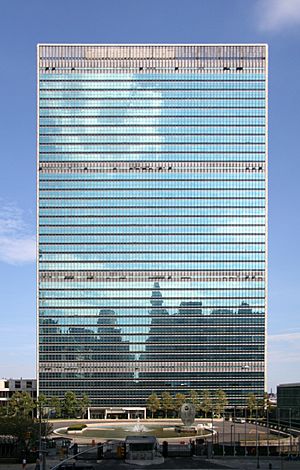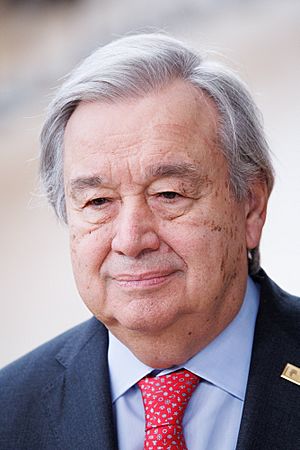Secretary-General of the United Nations facts for kids
The Secretary-General of the United Nations (often called the UN Secretary-General or UNSG) is like the main leader and manager of the United Nations. They are in charge of the United Nations Secretariat, which is one of the six main parts of the UN.
The job of the Secretary-General and the Secretariat is explained in the United Nations Charter. However, many details about how someone becomes Secretary-General and how long they serve have been decided over time by tradition.
Quick facts for kids Secretary-General of the United Nations |
|
|---|---|

|
|

|
|
| United Nations Secretariat | |
| Style | His Excellency |
| Abbreviation | UNSECGEN |
| Member of | Secretariat General Assembly |
| Residence | Sutton Place, New York City |
| Seat | United Nations Headquarters, New York City (international territory) |
| Nominator | Security Council |
| Appointer | General Assembly |
| Term length | Five years, renewable
(traditionally limited to two terms)
|
| Constituting instrument | United Nations Charter |
| Precursor | Secretary-General of the League of Nations |
| Formation | 24 October 1945 |
| First holder | Gladwyn Jebb as acting Secretary-General Trygve Lie as first Secretary-General |
| Deputy | Deputy Secretary-General |
| Salary | $ 227,253 per annum (2024) |
Contents
How the Secretary-General Is Chosen

The Secretary-General is chosen by the General Assembly. This happens after the Security Council suggests a candidate. The Security Council has five permanent members (China, France, Russia, the United Kingdom, and the United States). Any of these five countries can say no to a candidate, which is called a veto. Because of this, the person chosen is often someone who is acceptable to all major powers.
There are also some unofficial rules for who can be chosen. For example, the person cannot be a citizen of any of the five permanent Security Council members. Also, the UN tries to choose people from different parts of the world and hopes to have a woman in the role one day. So far, all Secretaries-General have been experienced diplomats.
Term Length
The Secretary-General usually serves for five years. They can be chosen again for a second term. Most Secretaries-General since 1961 have served two terms. There isn't a strict limit on how many terms someone can serve, but usually, they don't try for a third term.
The process of choosing the Secretary-General used to be very private. However, in 2016, the General Assembly tried to make it more open. They asked for nominations and held public discussions. Still, the Security Council made its final decision in private.
What the Secretary-General Does
The UN Charter says the Secretary-General is the "chief administrative officer" of the UN. This means they are in charge of the UN's daily operations and staff. The Secretary-General can also tell the Security Council about any issue that they think might threaten world peace. They also do other tasks given to them by different UN groups.
The UN describes the Secretary-General's job as being a mix of different roles:
- Advocate: Speaking up for people around the world and for UN goals.
- Diplomat: Working with countries to solve problems peacefully.
- Civil Servant: Managing the UN's large staff and operations.
- Chief Executive Officer: Leading the entire UN system.
The Secretary-General's daily duties include:
- Overseeing the work of the UN staff.
- Attending meetings with different UN groups.
- Talking with world leaders and government officials.
- Traveling globally to highlight important international issues.
They also publish a yearly report about the UN's work, explaining what has been done and what needs to be focused on next. The Secretary-General also leads a group of heads from all UN funds and agencies, who meet twice a year to discuss important issues.
Many of the Secretary-General's powers are informal. They often use their "good offices" to help prevent international disagreements from starting or getting worse. This means they use their independent and fair position to talk to different sides and find solutions. People sometimes call the job the "world's moderator" because they help bring people together. For example, past Secretaries-General have helped calm down conflicts, like the Cuban Missile Crisis.
Official Home
The official home of the Secretary-General is a house at 3 Sutton Place, Manhattan, in New York City, United States. This house was given to the United Nations in 1972.
Past Secretaries-General
| No. | Portrait | Name | Time in Office | Country | UN Regional Group | Key Facts | ||
|---|---|---|---|---|---|---|---|---|
| Started | Ended | Total Time | ||||||
| Acting |  |
Gladwyn Jebb | 24 October 1945 | 2 February 1946 | 101 days | Western European and Others | He was the acting Secretary-General when the UN was first being set up after World War II. | |
| 1 |  |
Trygve Lie | 2 February 1946 | 10 November 1952 | 6 years, 282 days | Western European and Others | He was the first official Secretary-General. He resigned in 1952. | |
| 2 |  |
Dag Hammarskjöld | 10 April 1953 | 18 September 1961 † | 8 years, 312 days | Western European and Others | He was re-elected for a second term. He sadly died in a plane crash in 1961 while on a peace mission. He won the Nobel Peace Prize after his death. | |
| Acting |  |
U Thant | 3 November 1961 | 30 November 1962 | 1 year, 27 days | Asia-Pacific | He was the first Secretary-General from Asia. He served as acting Secretary-General before being fully appointed. | |
| 3 | 30 November 1962 | 31 December 1971 | 9 years, 31 days | He was reappointed for a full term and did not seek a third term. | ||||
| 4 |  |
Kurt Waldheim | 1 January 1972 | 31 December 1981 | 9 years, 364 days | Western European and Others | He served two terms. After his time at the UN, he became the president of Austria. | |
| 5 |  |
Javier Pérez de Cuéllar | 1 January 1982 | 31 December 1991 | 9 years, 364 days | Latin American and Caribbean | He was the first and only Secretary-General from the Americas. He was re-elected for a second term. | |
| 6 |  |
Boutros Boutros-Ghali | 1 January 1992 | 31 December 1996 | 4 years, 365 days | African | He was the first Secretary-General from Africa. He served one term. | |
| 7 |  |
Kofi Annan | 1 January 1997 | 31 December 2006 | 9 years, 364 days | African | He was also from Africa and served two terms. He and the United Nations won the Nobel Peace Prize in 2001. | |
| 8 |  |
Ban Ki-moon | 1 January 2007 | 31 December 2016 | 9 years, 365 days | Asia-Pacific | He was the first Secretary-General from East Asia. He served two terms. Before this, he was the Foreign Minister of South Korea. | |
| 9 |  |
António Guterres | 1 January 2017 | Incumbent | 8 years, 339 days | Western European and Others and Asia-Pacific | He is the current Secretary-General. He was the prime minister of Portugal before taking this role. His second term began on January 1, 2022. | |
Images for kids
Secretaries-General by Region
| UN Regional Group | Number of Secretaries-General | Number of Terms Served |
|---|---|---|
| WEOG | 4 | 7 |
| Eastern European Group | 0 | 0 |
| GRULAC | 1 | 2 |
| Asia-Pacific Group | 3 | 6 |
| African Group | 2 | 3 |
See also
 In Spanish: Secretaría General de las Naciones Unidas para niños
In Spanish: Secretaría General de las Naciones Unidas para niños
- Under-Secretary-General of the United Nations



